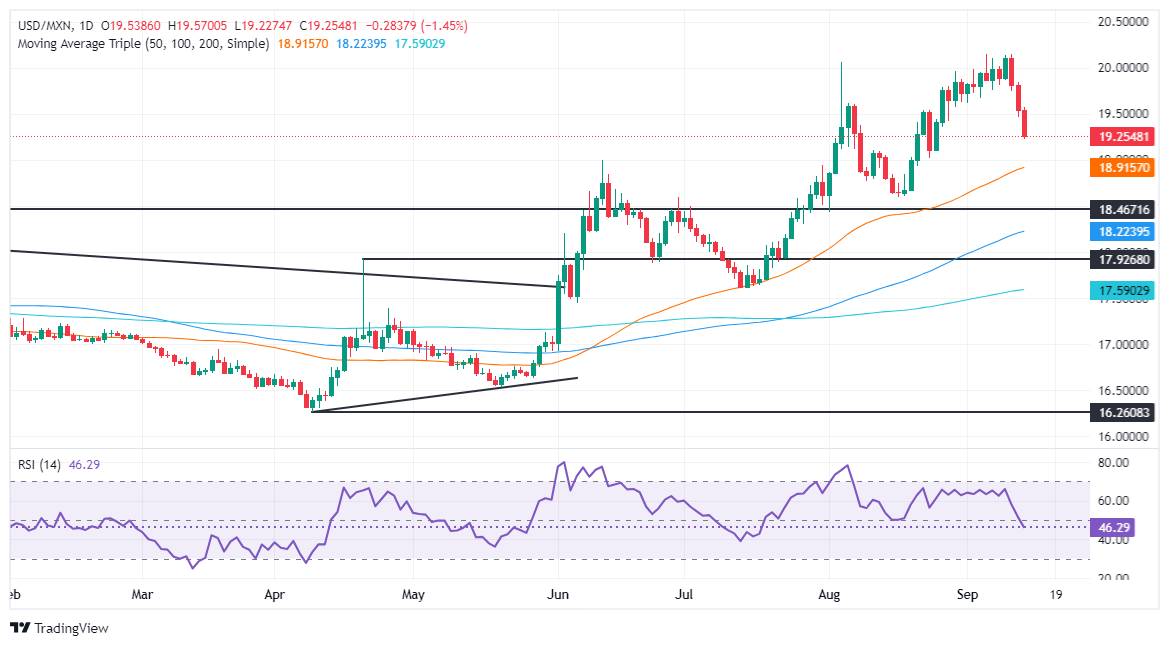- Mexican peso rises to three-week high as US dollar falls
- Fed rate cut expectations are rising with the CME FedWatch tool showing a 43% probability of a 50bps cut, putting pressure on the US Dollar.
- Political concerns in Mexico ease after passage of judicial reform, helping peso rally.
The Mexican Peso rallied for the third consecutive session against the US Dollar due to the latter’s overall weakness. Market participants’ confidence that the US Federal Reserve (Fed) will reduce borrowing costs “aggressively” boosted the Mexican currency, which dismissed fears of judicial reform. USD/MXN is trading at 19.25, down 1.30%.
The dollar has been in focus over the past two trading sessions. On Thursday, investors seemed confident that the Fed will cut interest rates by 0.25% due to data provided by the CME FedWatch tool. However, a worse-than-expected initial jobless claims report overshadowed a rise in the Producer Price Index (PPI).
On Thursday, the CME FedWatch tool showed the odds of a 50 basis point Fed cut at 28%. However, at the time of writing, the odds had risen to 43%; and for a 25 bps cut, they had declined to 53%.
This undermined the dollar, which, according to the US Dollar Index (DXY), lost 0.17%, changing hands at 101.06.
The University of Michigan (UoM) revealed that Consumer Sentiment rose to a four-month high in September, helped by an improvement in inflation expectations.
Meanwhile, in Mexico, political turmoil eased following the passage of the judicial system bill.
Gerardo Carrillo, Regional Director for LATAM at Fitch Ratings, commented on Mexico’s creditworthiness. He said, “The rating outlook is stable, meaning we are seeing a balance between strengths and weaknesses. Before seeing a direct downgrade of the sovereign rating, what could be expected from us is a change in outlook, either from stable to positive or from stable to negative, with the latter likely to occur.”
On Thursday, the Director of Economic Research at the Bank of Mexico (Banxico), Alejandrina Salcedo, said that a robust environment in the rule of law can help generate conditions that encourage investment. She added that respecting the rule of law and public security “would provide greater certainty, boost the flow of investment in all regions and contribute to capitalizing on the opportunities offered by the relocation process.”
Market drivers: Mexican peso strengthened by weaker US dollar
- USD/MXN is expected to continue to be driven by market sentiment and expectations of further Fed rate cuts.
- Mexico’s economic agenda next week will include Aggregate Demand and Private Spending for the second quarter of 2024.
- Mexico’s inflation fell below 5% in August, raising the prospects for further easing by Banxico.
- Citibanamex’s September survey showed that Banxico is expected to cut rates to 10.25% in 2024 and 8.25% in 2025. The USD/MXN exchange rate is forecast to end 2024 at 19.50 and 2025 at 19.85.
- The UoM Consumer Sentiment Index rose from 67.9 to 69.0, beating estimates of 68.
- Inflation expectations improved from 2.8% to 2.7% for the one-year period. Over the longer term, they rose from 3% to 3.1%.
- The dollar remained offered in the US after the US Bureau of Labor Statistics revealed that August PPI figures were mixed. At the same time, the number of Americans who filed for unemployment benefits rose as estimated and exceeded the previous week’s reading.
- Data from the Chicago Board of Trade suggest the Fed will cut at least 98 basis points this year, up from 108 a day ago, based on the December 2024 federal funds rate futures contract.
USD/MXN Technical Outlook: Mexican Peso Soars as USD/MXN Dips Below 19.30
The sudden pullback in the USD/MXN pushed the exotic pair more than 7,000 pips below the psychological figure of 20.00, although key support levels lie ahead. However, momentum shifted in favor of sellers as the Relative Strength Index (RSI) turned bearish.
Therefore, in the short term, the USD/MXN is tilted lower. The first support would be the August 23 low of 19.02. A break of the latter will expose the 50-day simple moving average at 18.99, followed by the August 19 cycle low of 18.59.
On the contrary, USD/MXN must surpass the psychological figure of 20.00 for a bullish continuation. If overcome, the next resistance level would be the yearly high of 20.22. With further strength, the pair could challenge the daily high of September 28, 2022 at 20.57. If those two levels give up, the next stop would be the swing high of 20.82 on August 2, 2022, ahead of 21.00.
Mexican Peso FAQs
The Mexican Peso is the legal currency of Mexico. The MXN is the most traded currency in Latin America and the third most traded currency in the Americas. The Mexican Peso is the first currency in the world to use the $ sign, prior to the later use of the Dollar. The Mexican Peso or MXN is divided into 100 cents.
Banxico is the Bank of Mexico, the country’s central bank. Created in 1925, it provides the national currency, the MXN, and its primary objective is to preserve its value over time. In addition, the Bank of Mexico manages the country’s international reserves, acts as a lender of last resort to the banking sector, and provides economic and financial advice to the government. Banxico uses the tools and techniques of monetary policy to achieve its objective.
When inflation is high, the value of the Mexican Peso (MXN) tends to decrease. This implies an increase in the cost of living for Mexicans, which affects their ability to invest and save. In general, inflation affects the Mexican economy because Mexico imports a significant amount of final consumer products, such as gas, fuel, food, clothing, etc., and a large amount of production inputs. On the other hand, the higher the inflation and debt, the less attractive the country is for investors.
The exchange rate between the USD and the MXN affects imports and exports between the United States and Mexico, potentially affecting demand and trade flows. The price of the Dollar against the Mexican Peso is affected by factors such as monetary policy, interest rates, the consumer price index, economic growth and some geopolitical decisions.
The exchange rate between the USD and the MXN affects imports and exports between the United States and Mexico, potentially affecting demand and trade flows. The price of the Dollar against the Mexican Peso is affected by factors such as monetary policy, interest rates, the consumer price index, economic growth and some geopolitical decisions.
Source: Fx Street
I am Joshua Winder, a senior-level journalist and editor at World Stock Market. I specialize in covering news related to the stock market and economic trends. With more than 8 years of experience in this field, I have become an expert in financial reporting.








